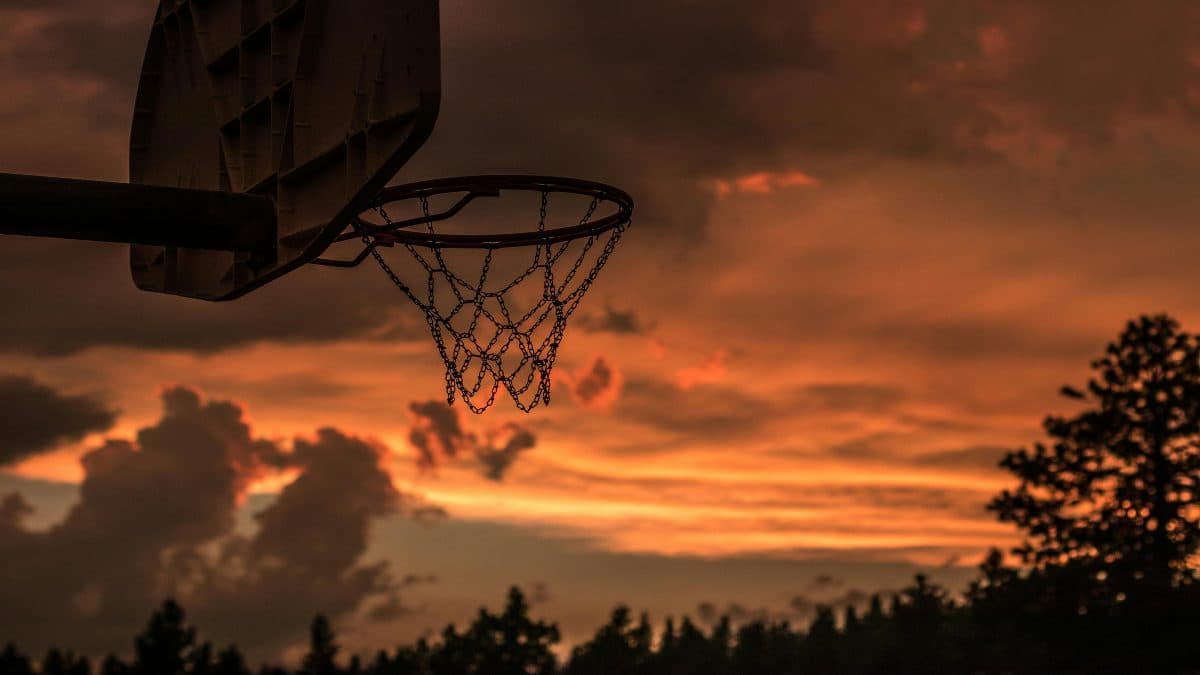The 24 second rule in basketball
By Pinkey Sharma |
Date 25-09-2024

Table of Contents
Admissions Open for
The 24 second rule Basketball is very dynamic that combines the component of physical agility with mental sharpness. Among the many rules within basketball that would keep the tempo up and make the game interesting is the 24 second rule basketball. The rule does not clarify the strategies to be used by the teams, but it also makes the match more intriguing for both players and fans. In this paper, we will look at the 24 second rule basketball by discussing its origin, importance, and influence on the game.
24-Second Rule Origins
The 24 second rule, or shot clock rule, was adapted by the National Basketball Association in 1954. Before the implementation of this rule by the administrator, different teams used to waste their time by continuously dribbling the ball for minutes without taking a field goal. This usually resulted in low-scoring games, which also killed the fans' excitement. This was a problem predominantly when a team had a lead and started playing the clock, making a comeback nearly impossible.
Then Danny Biasone, owner of the Syracuse Nationals, suggested they implement something like a shot clock to quicken the pace of the game. Biasone—along with his general manager, Leo Ferris—figured that if both teams averaged 60 shots a game, the game would be exciting. An NBA game is 48 minutes long, or 2,880 seconds. If 120 trips up the floor is the magic number—each team getting 60—the math says each trip would take 24 seconds.
Knowing the 24 Second Rule rule basketball
The only implication of the rule is that a basketball team is supposed to put up a shot within 24 seconds when in possession. Forfeit of possession arises if this is not done, where the possession is awarded to the opponent for the purpose of the game resumption.
According to the 24-second shot clock rule, for a shot to count, it must leave a player's hand before the expiration of the shot clock and hit the rim or enter the basket. If such a basket is made or if the ball bounces off the rim, then the shot clock goes back up to 24 seconds and play continues. Or misses the hoop completely, this would be a shot clock violation and a change of possession awarded to the opposing team.
In other cases, like offensive rebounds, it gets reset back to 14 seconds instead of the entire 24 seconds. This change was brought to make the game even faster, get more possessions, and as such make it even more interesting.
Impact on Strategy and Gameplay
The implementation of the 24 second rule basketball really redefined how the game was played. Stalling and wasting time were no longer permissible for teams; rather, they had to constantly move the ball to keep the intensity and get scoring opportunities. It has caused the following changes in strategies:
1. Pace of Play: The 24 second rule basketball forces the teams to have a fast pace, for it involves quick decisions on the part of the ball handlers and quick execution of plays. This turned the game into one of dynamism and fluidity, where fast breaks and quick transitions became very important parts of the game.
2. Offensive Strategies: Having the need to manufacture a shot in a very short time frame, this has led teams to develop an expansive, efficient, and complex offensive system in an attempt for a good look at the basket in time. It would include a lot of screens being set, pick-and-roll, and off-the-ball screens to free the scorers with possible space in time to score. It also highlights the importance of having skilled ball handlers and playmakers to create scoring opportunities against relentless ball pressure.
3. Defensive Pressure: The defensive mindset from the 24 second rule is one of ball pressure and turning over offenses. Full-court presses, trapping, and very strong on-the-ball defense are more common, as teams are trying to disrupt opposing offenses, ideally forcing a hurried shot.
4. Clutch Situations: In close games, with the clock running down, the shot clock produces additional drama and excitement because teams have to work the clock, trying to score while taking away as much time as possible. This has meant considerable drama even at game endings, including with every second and possession.
A shot clock violation would result from the offensive team not defending a shot on the goal ring that hits the rim, and before the expiration of 24-seconds, the shot is made. After the occurrence, the team commits the violation, the referee upon occurrence blows the whistle and awards possession of the ball to the opposite direction. The quick pass up the floor is one of the most common turnovers in basketball, thus making teams strive to keep it at bay by having the clock in the back of their minds and make time-conscious decisions.
The other element that enforces the 24 second rule basketball is the work of the shot clock operator, who starts and resets the clock according to the rules. This operator needs to be very precise with the timing for the game to be played as fairly as possible and with the application of the rule. Normally, the shot clock is noted up on the basket or on the scoreboard, and it is therefore visible to the players and the fans as well as the coach.
Evolution and Contemporary Modifications
Although there have been several changes to the 24 second rule over the years the integrity of the reason behind its implementation is still held true, the spontaneity of basketball itself. One of the more significant changes was adding the 14-second reset in certain situations such as after an offensive rebound or a defensive foul. This way keeps the tempo fast flow and also does not waste time to try and save the time that teams can use when having a new possession of the basketball.
Along with those are the other time-related rules: the 8-second rule, where a team needs to advance the ball past half-court within eight seconds, and the 3-second rule, which governs how long a player can spend in the key. The rules all control the regulations of the game. Teams can't just run out the game clock.
The 24 second rule basketball has even impacted the international game, as most of the international basketball leagues, including FIBA, have also put in place similar rules in terms of the shot clocks. Therefore, these were the rules that largely unified the game to the point that it easily enabled the players and fans to follow up the game with ease in different aspects.
Knowing the 24 second rule basketball is not only important to a player or a coach but also to any fan desiring to know how strategic the game can be. The rule stands as a very integral part of basketball, whose importance is understood by trying to find out why precisely the 24 seconds were selected and how it affects the gameplay, especially to young players and fans.
Why 24 Seconds?
The reason the SCT went within 24 seconds wasn't something they threw a dart at the wall and landed on. Based on comments added to the information already shared, Danny Biasone wanted to speed the game up to make it more exciting for fans. He came up with the 24-second shot clock by working out the pace of play to allow for a good offense versus defense. This time frame was regarded as perfect in that it allowed a team just enough space to set up a play and get off a shot while keeping the game moving quickly.
Now why 24 seconds, and not 20, 30, or otherwise? This is basically because 24 seconds allows for enough time to initiate and implement a play but not enough time to stall the game. A shorter shot clock might leave the teams without enough time to set up a good shot, which could result in more hurried, poor-quality shots. The reason is that if it was longer, teams might take too much time, and it slows down the game, therefore less interesting.
If this were not so, teams would essentially operate an unstoppable dribbling drill until the finish, boring everyone in the process as they played out the clock without attempting to score. With a 24-second cap, the rule makes sure that teams will get fresh chances at scoring, keeping the game moving without stopping.
The 24 second rule basketball is cardinal , as it has a direct impact on selecting and tempoing the rhythm of games. It subjects a side to play under immense speed, mostly seeing to it that quicker, smoother ways of play are introduced. Teams that think fast and move quickly are often much more successful because they take advantage of the time constraint placed on them to create scoring opportunities.
The latter has a massive influence on the game of both offense and defense. Offensively, this limitation means that a team must be very effective with the number of possessions that they get. If they have about 24 seconds to use the ball, then they have to work and get the best shot available from an offense, which might mean setting screens and moving the ball around. This is what spawned the many different plays and systems developed to function within the confines of this clock.
This puts added pressure on the defenders to manhandle the offense and either force a bad shot or besmirch it into a turnover. Defenders realize that if they're able to hold that suffocating defense for the full 24 seconds, they stand a great chance to get a stop against their opponents. The pressure caused them to trap and press, creating a situation of quick decisions and mistakes on the defensive end.
Teaching Kids about the 24 Second Rule basketball
So you're a young basketball player, or you just enjoy watching the game, and knowledge of the 24-second rule adds further enjoyment to watching or playing this game. You are playing this contest where you have to take very quick turns, say, in musical chairs or perhaps in a timed puzzle. In basketball, the 24 second rule basketball is a countdown clock that says to the team with the ball, "Hurry up and take a shot before time runs out!"
This is how it works in simple terms: when a team gains possession of the ball, 24 second rule basketball allows them to have a go at the basket. Should they fail to release the ball within the given 24 seconds, the ball would be ceded to the rival team. This is very important in making the game entertaining. But with the 24-second game clock running, no team can hold onto the ball and be stingy, denying opponents a chance to play. That keeps everything moving fast and keeps the suspense up.
Imagine being on the court with your teammates, and you have to let the ball go before the buzzer sounds. You cannot just stand there, holding the ball, so you are forced to pass, dribble, and shoot before time is up. One is able to get trained to actually think and decide faster with one's mind and feet—one is trained in skills transferable to many things in life.
Conclusion
The 24 second rule basketball is an integral part of the game that ensures it is exhilarating and fast, yet strategic. It makes teams act urgently, plan wisely, and engage themselves in what is and could be an exciting contest. Little wonder it is thrilling for kids when they get to understand this rule. The Shot Clock is more than a rule—useful in itself—helpful and effective in itself to make basketball such an exciting, darting game loved by millions across the world.
The 24 second rule in basketball regards so much more than a time limit; it is woven into the fabric of the game, defining how basketball is played at all levels. From that origin of being a solution for the slow and low-scoring game, the rule has come a long way to its present status as a key ingredient in ensuring a sport is fast and exciting. It hugely affects strategy, play, and overall game flow. The 24-second rule will forever be a landmark in basketball as the sport expands and develops; it keeps the ability to keep the game exciting and more interesting for players and fans alike from across the world.
FAQs
What is a 24-second operator in basketball?
The 24-second operator shall be provided with a 24-second device and operate it so that it shall be: Started or restarted as soon as a player gains control of a live ball on the court. Stopped and reset to twenty-four (24) seconds as soon as: ➢ A shot for a field goal enters the basket.
What is the 30 second rule in basketball?
(1) The ball must leave the player's hand prior to the expiration of 30 seconds.
(2) After leaving the player's hand(s), the ball must make contact with the basket ring. If it fails to do so within 30 seconds, a 30- second violation has occurred.
What is a 24-second shot clock violation in basketball hand signal?
If playing in a league that uses a shot clock, teams will have 24 seconds to take a shot on each possession (some leagues use longer shot clocks). If a team fails to shoot within this time, the referee will call a 24-second violation. The referee will use one hand to tap the top of their shoulder on the same arm.
What happens after 24 second rule basketball?
The first violation is the 24-second rule. The attacking team has 24 seconds to attempt a field goal, from the moment they take possession of the ball. If by the end of the 24 seconds, the team still hasn't taken a shot, the referee will whistle and turn the ball over to the other team.
Liked the blog? Share it with your friends and let everyone know about the 24 second rule of basketball
Other Related Sections
NCERT Solutions | Sample Papers | CBSE SYLLABUS| Calculators | Converters | Stories For Kids | Poems for Kids| Learning Concepts | Practice Worksheets | Formulas | Blogs | Parent Resource
CBSE Schools In Popular Cities
- CBSE Schools in Bangalore
- CBSE Schools in Mumbai
- CBSE Schools in Pune
- CBSE Schools in Hyderabad
- CBSE Schools in Chennai
- CBSE Schools in Gurgaon
- CBSE Schools in Kolkata
- CBSE Schools in Indore
- CBSE Schools in Sonipat
- CBSE Schools in Delhi
- CBSE Schools in Rohtak
- CBSE Schools in Bhopal
- CBSE Schools in Aurangabad
- CBSE Schools in Jabalpur
- CBSE Schools in Jaipur
- CBSE Schools in Jodhpur
- CBSE Schools in Nagpur
- CBSE Schools in Ahmednagar
- CBSE School In Tumkur

Call Us to know more about Orchids
Swipe Up

.jpg&w=1920&q=80)














